ICM calculator now correctly calculates ICM EV for hero fold decision by taking into account possible course of actions from players who can act after hero
This article will go into details about most serious update since ICMIZER was released. Initially ICMIZER didn’t take into account possible actions which will occur if hero decides to fold, but they can greatly affect expected value for hero fold decisions. Current version now is taking all that into account, but it also complicates user interface considerably, because you need a way to assign each opponent with a range for all kinds of possible spots in case hero folds. For example, if we take a simple case and hero is considering a push from BTN, when we try to calculate hero Fold EV ICM wise and compare it with Push EV we need to take into account probability that SB player pushes, and that BB player might actually call him. Usually such course of actions increases our expected value, so when we ignore it completely we may get worse EV for fold decisions than it actually is.
When we take a more complex situation, say its 5 way and hero is under the gun. If he/she folds, CO may shove, and each player BTN, SB and BB could call him, if he/she folds, BTN could shove, and SB or BB could call him, and if it gets folded to SB it is often very likely that he/she shoves, and BB could call him.
So for each of those scenarios we can have a PUSH range for certain position, and a CALL range for positions of players who will act after pusher. In ICMIZER user interface PUSH ranges have a “PU” prefix, and call ranges have a “CA” prefix. Those abbreviations should be known to most serious SNG students. Push ranges and their corresponding call ranges are grouped into columns, which have thin dark gray boundaries and a caption on top a column. The most important column is HERO PUSH column, because it directly affects Push EV. It is the most important because if hero decides to fold, it will quite often get folded to BB, or to player who has pushed before hero. It is often unlikely that if hero folds, someone will definitely shove, that’s why if you want to get some fast results you may concentrate on first column, and not waste too much time with the other. Those results should satisfy beginner players, and they will be often quite close to ones ICMIZER produced before it had capability to take possible course of action after hero folds into account, but of course still better, because in reality each player after hero has a certain push range and a call range against other players.
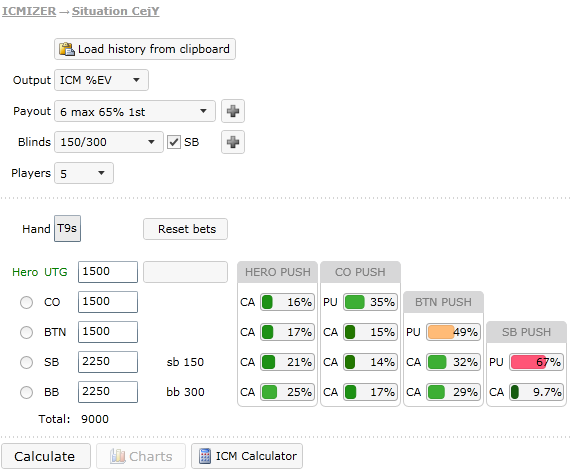
So if you want to really get some meaningful results you will need to input all the ranges which are editable for situation. It may look like a tough job, and ICMIZER currently isn’t trying to look like it knows your opponents better than you do and how wide they are going to shove and to call. So you will need to manually input those, or results won’t be as precise as they could be. When done correctly, you may find that what previously looked like a clear shove now is actually a fold, and vice versa.
About new way of defining a poker situation
Our old ICM calculator version had 3 modes – call, push and resteal. In new version modes are not present anymore, but instead you can input any kind of situation, which is: player stacks, bets and hero position. There is also no more “villain” because now due to “range columns” any player who can possibly act is a potential winner of a hand. This way you can set some players bets, some player raises or limps, and then analyze the whole situation and calculate ICM Ev PUSH and Ev Fold for hero. So this interface is completely different when compared to old version. We hope that bet size popup should be fairly intuitive to poker players because it mimics same functionality of poker clients to some extent.
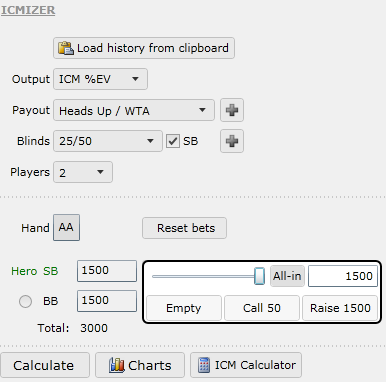
While our goal is to have as many situations analyzable as possible, currently ICMIZER can analyze not much more situations than initial version could. They still cover most common spots in tournament poker – push, call and resteal. However many more situations are going to be supported, like ones where multiple players raise and re-raise, or situations after hero voluntarily puts money in the pot, and is facing a push/fold decision from the players on late positions. In the next screenshots you can see how to analyze common spots using new interface.
Old "Call Mode" spot
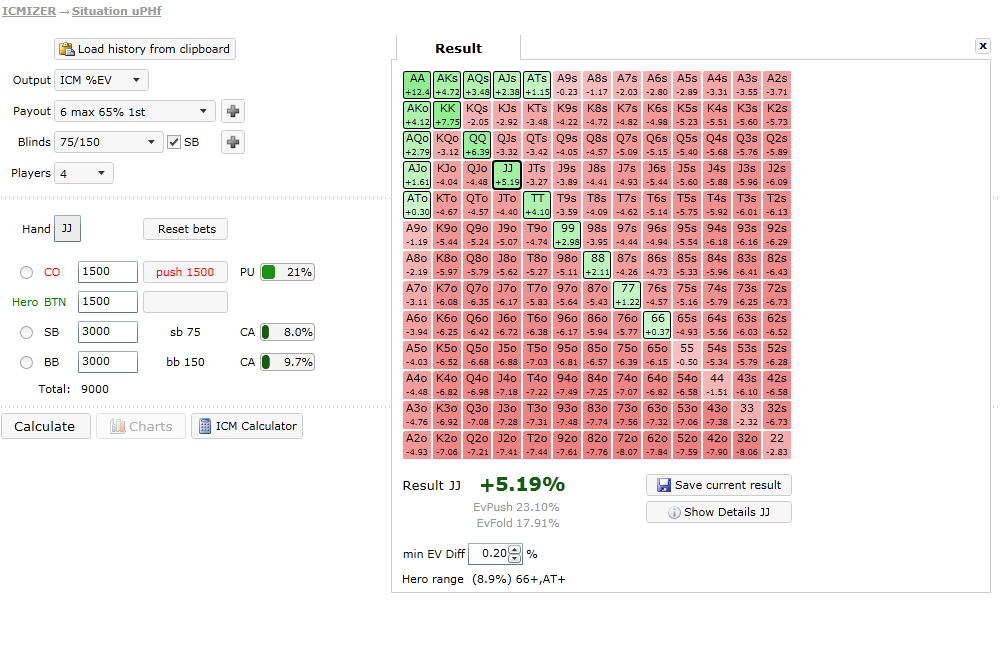
In this case you assign an all-in bet for a single player before hero. Other bets should remain default.
http://www.icmpoker.com/icmizer/#uPHf
Old "Push Mode" spot
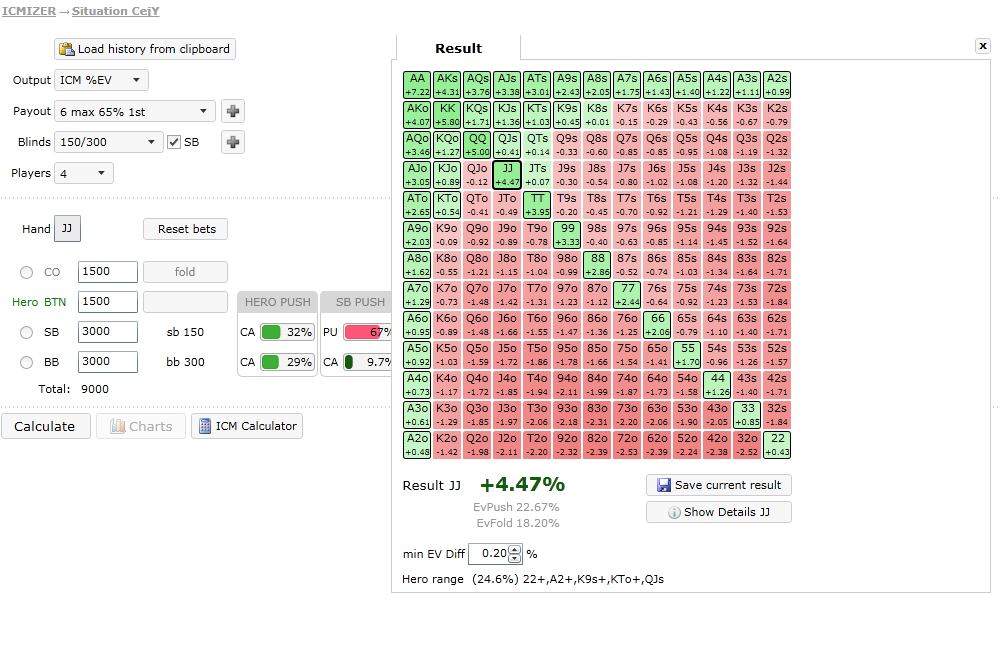
In this case you don’t assign any bets, hero is considering a shove and didn’t bet anything yet. Just choose a hero position and you get a PUSH MODE situation.
http://www.icmpoker.com/icmizer/#CejY
Old "Resteal Mode" spot
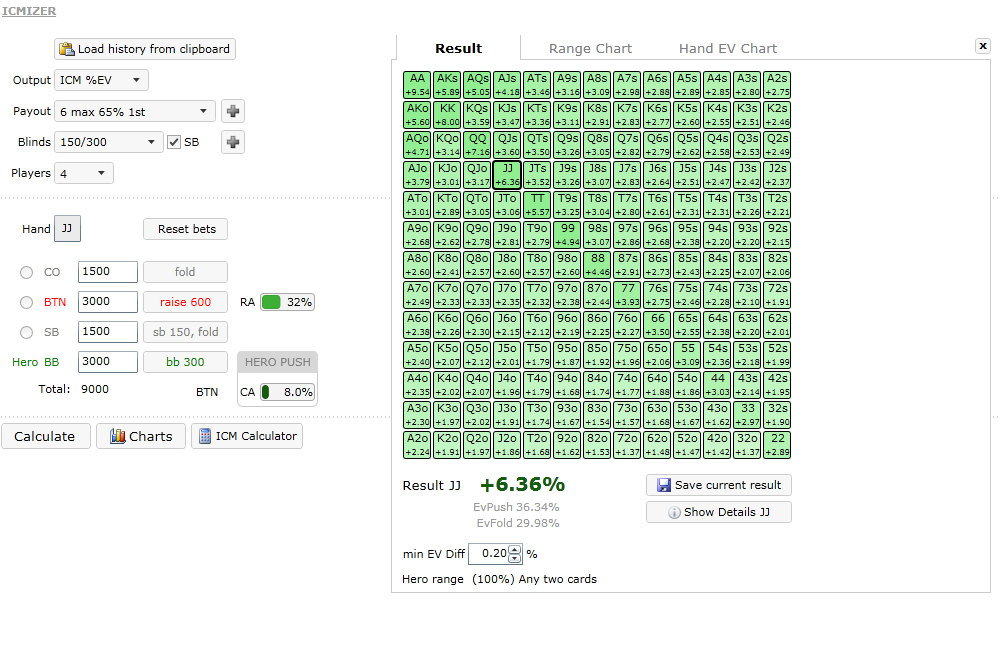
For this spot you assign a raise size for some player before hero. Notice that it shouldn’t be an all-in bet or situation becomes a CALL MODE spot. Resteal situations are now handled a little different than in previous version of ICMIZER. You assign a Raise range (it will have a “RA” prefix from “Raise”) and then you edit a call resteal range (“CA” prefix) for this player in corresponding column. So for example, for hero resteal you will need to edit last range in HERO PUSH column. If you want to setup a resteal range for BB player you assign it in BB PUSH column, and set “CA” range for raiser against BB push in the same column. Notice that now you can edit “call resteal ranges” with mouse, which was not available in previous version of ICMIZER and was a requested feature, because previously it presented both ranges in single user interface window. Now raise and call resteal ranges are edited separately. Of-course, call resteal range cannot contain hands that aren’t present in initial raise range.
http://www.icmpoker.com/icmizer/#QHqb
Charts changes
It was reported that it was unclear what charts mean for pushes from UTG with many players, and that it is questionable that they are of any use. We think that indeed in some cases previous charts could be misleading so now charts are only available for spots where they provide actual useful data. Those spots are limited to clear heads up spots, when hero is facing a single player action and no other players can interfere between them. Those include all two way spots, push from SB, call from BB, and resteal from BB. For other situations Charts are not available anymore, because a 2d axis cannot display ranges for more than 2 players in a useful way. So charts are now mostly a HU instrument, but they can be still used for most BvB scenarios too.
Calculation details window popup
Previously ICMIZER didn’t have a clear interface to provide information about how actual EV for Fold and Push decisions were calculated. Now after you hit Calculate button you will have an ability to request calculations details. Select a hand you want details for, and click Show Details button. You will get an informative popup window with all the probabilities, and corresponding hero ICM calculated expected values displayed. Notice that this window will have little use for most players, but if you are really curious and want to see what is actually behind those calculated expected values or how complex actual calculation is – this window is available now.
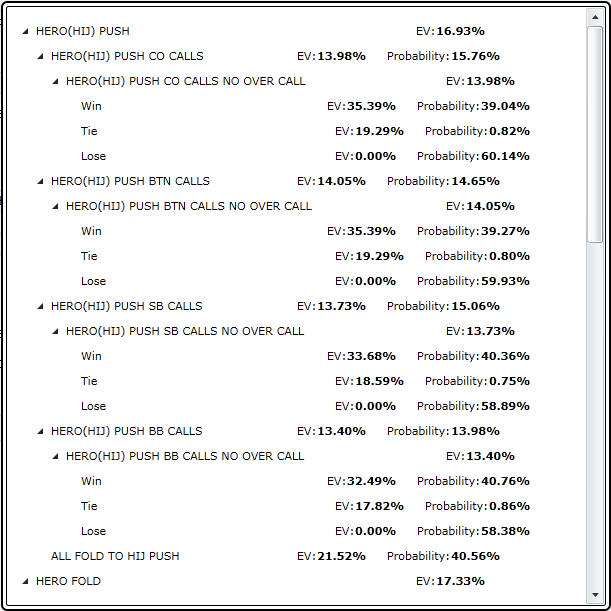
Thats a short review of current update. Please leave specific questions in comments if you have any.